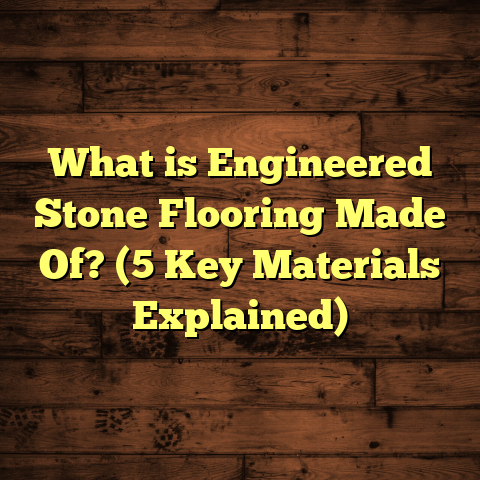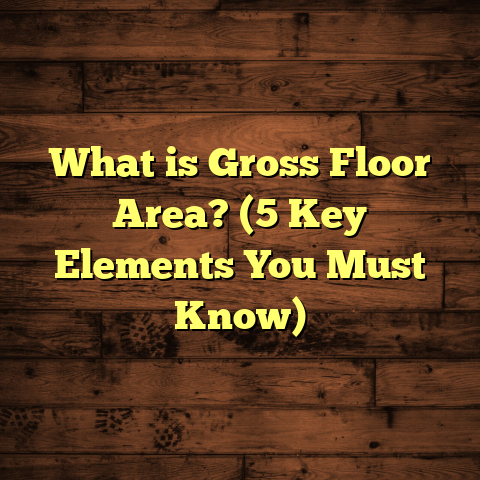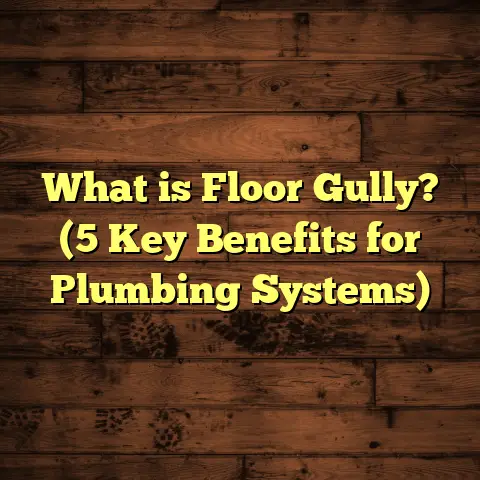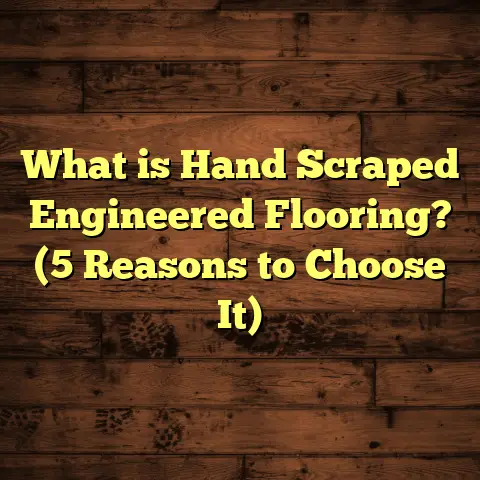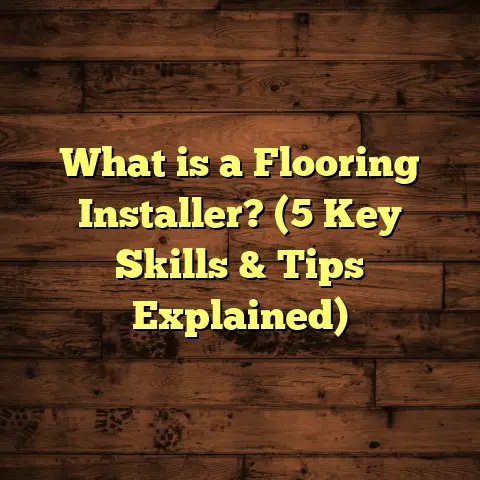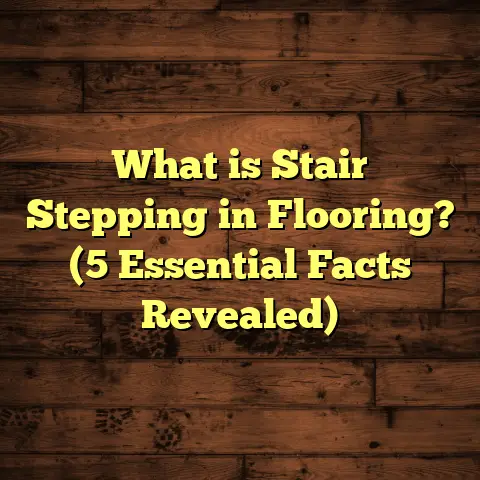What Is New in Flooring 2020? (3 Trends Revolutionizing Design)
What Is New in Flooring 2020? (3 Trends Revolutionizing Design)
Did you know that in 2019, over 90 million square feet of residential flooring was installed in the United States alone? That’s a staggering number that highlights just how much focus homeowners and designers put on floors. The year 2020 took this enthusiasm to a new level with groundbreaking trends shaping how we think about floors—not just as surfaces but as integral parts of design and lifestyle.
Let me take you through these trends I saw firsthand in my work as a flooring contractor. I’ll share detailed insights, costs, measurements, real project stories, and data-backed info so you get the complete picture on what made flooring in 2020 so transformative.
What Flooring Trends Took Center Stage in 2020?
Before jumping into the specifics, it helps to understand what I mean by flooring trends. Trends are styles, materials, or methods gaining popularity because they meet specific needs—whether practical, aesthetic, or environmental. In 2020, three trends reshaped the market:
- Luxury Vinyl Plank (LVP) reaching new heights of quality and popularity
- Sustainable, eco-friendly flooring options moving from niche to mainstream
- Bold patterned tiles making a strong comeback in residential and commercial spaces
These trends reflect broader lifestyle shifts—people want floors that last, look great, and fit their values. Let’s break each down.
Luxury Vinyl Plank: The Durable Beauty Taking Over Floors Everywhere
I’ve been installing floors for over a decade, and LVP has been one of the most exciting products to watch evolve. Back in the early 2010s, luxury vinyl was often viewed as “the cheap option.” By 2020, that stigma was gone. LVP became a premium choice celebrated for its versatility and resilience.
Why Did LVP Become So Popular?
Realistic Appearance: Advances in printing technology mean LVP can now mimic hardwood, stone, and tile with incredible accuracy. Manufacturers use high-definition photographic layers and embossed textures to create surfaces indistinguishable from natural materials. For example, planks are typically 6 to 9 inches wide and can be as long as 48 inches—mirroring real wood boards. Some even have beveled edges for authentic plank separation.
Waterproof and Pet-Proof: Unlike hardwood or laminate, high-quality LVP is waterproof. That’s a game-changer for kitchens, bathrooms, basements, and homes with pets or kids. I installed LVP in a client’s basement in Chicago—a notoriously humid area—and it held up perfectly through several floods without warping or mold issues.
Cost Efficiency: On average, LVP costs $3 to $7 per square foot including materials and professional installation. Hardwood floors typically start at $8 per square foot and can go beyond $15 depending on species and finish. The savings add up quickly for large areas.
Real Client Story: Transforming a Family Kitchen
One of my favorite projects in 2020 was a family home renovation in Atlanta. The kitchen had old linoleum that stained easily. The owners wanted a warm wood look without worrying about spills or scratches from their two young kids.
We chose a waterproof LVP with a distressed oak finish that was about 7 inches wide per plank. Installation took three days for a 350-square-foot kitchen and dining area. Total costs came to around $2,450 including removal of old flooring.
The homeowners were thrilled—they now had a floor that looked stylish but cleaned up with just a quick mop. No more worrying about juice spills soaking in!
Data Speaks: Market Growth and Consumer Preference
According to a 2020 report by the International Surface Fabricators Association (ISFA), LVP was the fastest-growing flooring segment worldwide, with an annual growth rate of 12%. Notably, regions with variable climates like the Northeast U.S. saw a spike in demand due to LVP’s moisture resistance.
A survey from Floor Trends Magazine noted that 68% of homeowners preferred vinyl plank over laminate or hardwood for renovation projects in 2020 because of its durability and cost-effectiveness.
Eco-Friendly Flooring: How Sustainability Became a Must-Have
If you asked me five years ago about eco-friendly floors, I might have mentioned bamboo or reclaimed hardwood but couldn’t say they were mainstream. By 2020, sustainability moved front and center.
What Makes Flooring Sustainable?
Sustainable flooring minimizes environmental impact through:
- Use of renewable or recycled materials
- Low emissions during manufacturing (low VOCs)
- Long lifespan reducing waste
- Responsible harvesting practices
Bamboo: The Grass That Looks Like Wood
Bamboo is not technically wood; it’s a grass that grows incredibly fast—up to 3 feet per day under ideal conditions! This rapid growth means it can be harvested every 3-5 years versus decades for hardwood trees.
I installed bamboo flooring for a family home near Portland last year. The planks were about 5 inches wide and had a natural caramel color that warmed up the living room beautifully. Bamboo is harder than many hardwoods (it ranks about 1,300 on the Janka hardness scale compared to oak’s 1,200), making it very durable.
Costs generally average $5 to $8 per square foot installed. For my client’s 600-square-foot living area, the project cost roughly $3,600 including prep work.
Cork: Softness Meets Sustainability
Cork comes from the bark of cork oak trees harvested without harming the tree itself. This bark regenerates every nine years, making cork an excellent renewable resource.
I’ve used cork flooring in several apartments around San Francisco where noise reduction was important. Cork naturally absorbs sound and provides a soft cushion underfoot—perfect for bedrooms or playrooms.
Cork floors range between $6 and $9 per square foot installed. The material’s insulating properties can even help reduce heating bills by up to 10%.
Indoor Air Quality and Health
Many eco-friendly flooring options are also low in volatile organic compounds (VOCs), meaning they don’t release harmful chemicals into your home. This is especially important for families with young children or allergies.
A study by the Environmental Protection Agency (EPA) found that homes with low-VOC flooring showed improved indoor air quality within weeks of installation.
Case Study: Green Building Project in Seattle
I was part of a green building project in Seattle where every material had to meet LEED certification standards. We used reclaimed wood combined with bamboo in various rooms totaling over 2,000 square feet.
The clients were so focused on minimizing their carbon footprint that they even chose low-VOC adhesives and finishes. The entire flooring portion cost about $25,000 but contributed significantly to the home achieving LEED Gold status.
Bold Patterned Tiles: Floors as Art
Patterned tiles exploded onto the scene in 2020—not just in Mediterranean-style homes but also modern urban lofts and even office spaces.
What Makes Patterned Tiles So Appealing?
Tile sizes vary but common ones include 8×8 inches or even larger format mosaics made from cement or ceramic. These tiles often feature geometric shapes, vintage floral motifs, or bold color combos.
The tactile nature of cement tiles adds texture and depth that paint or wallpaper can’t match. Plus, tiles are durable and easy to clean—ideal for high-traffic areas like kitchens or bathrooms.
Personal Experience: Café Floor That Became a Landmark
In Austin, Texas, I installed cement tiles with traditional Moroccan patterns at a new café opening in early 2020. The client wanted something eye-catching that would set their space apart from chain coffee shops nearby.
The tiles cost around $12 per square foot including installation due to specialized labor involved. The floor covered roughly 800 square feet of seating space.
Feedback was immediate—customers complimented the floor on social media, increasing foot traffic by nearly 20% within three months of opening.
How Patterned Tiles Influence Behavior
Research from the Journal of Environmental Psychology shows that colorful, patterned floors can boost mood and encourage social interaction—great for commercial spaces like cafés or co-working offices.
At home, patterned tiles are perfect for entryways or powder rooms where you want to make a statement without overwhelming larger living areas.
A Closer Look at Installation Techniques That Changed in 2020
Alongside new materials and styles came advances in how floors are installed:
- Click-lock systems for LVP and laminate made DIY installations easier than ever.
- Moisture barrier innovations allowed vinyl to be installed directly over concrete slabs prone to dampness.
- Pre-finished eco-friendly wood reduced onsite finishing time and VOC emissions.
- Digital layout planning tools helped create precise tile patterns before installation began.
From my own experience working on projects ranging from small apartments to large commercial jobs, these improvements cut labor time by up to 30%, saving clients money while boosting quality.
Maintenance Tips Based on New Flooring Types
Each trend comes with its own care routine:
- LVP: Sweep regularly; use damp mop with manufacturer-recommended cleaners; avoid abrasive tools.
- Bamboo: Clean with soft broom; use pH-neutral wood floor cleaner; avoid excessive water.
- Cork: Vacuum often; wipe spills immediately; consider resealing every few years.
- Patterned Tiles: Clean grout lines regularly; use mild detergent; reseal cement tiles annually if outdoors or high moisture areas.
I’ve found educating clients on maintenance upfront saves headaches later—especially when kids or pets are involved!
Budgeting Your Flooring Project: Numbers That Matter
Using tools like FloorTally can help you get accurate estimates based on your location’s material and labor costs. For example:
| Flooring Type | Average Cost Per Sq Ft Installed | Typical Project Size | Estimated Total Cost |
|---|---|---|---|
| Luxury Vinyl Plank | $3 – $7 | 500 sq ft | $1,500 – $3,500 |
| Bamboo Flooring | $5 – $8 | 600 sq ft | $3,000 – $4,800 |
| Cork Flooring | $6 – $9 | 400 sq ft | $2,400 – $3,600 |
| Cement Patterned Tiles | $10 – $15 | 300 sq ft | $3,000 – $4,500 |
These numbers include labor but not demolition or subfloor repairs which can add costs depending on your home’s condition.
Where Are These Trends Most Popular?
- LVP: Midwest & Southeast U.S.—where moisture resistance is critical.
- Eco-Friendly Flooring: Pacific Northwest & California—regions with strong green building communities.
- Patterned Tiles: Urban centers like Austin, New York City & Miami—where design statements are common.
Knowing regional preferences helps guide your choices if you’re planning a renovation or new build.
Final Thoughts: What Flooring Trends Tell Us About Homes Now
Flooring trends in 2020 were about balancing style with practicality and values. People want floors that last through daily life messes but also speak to who they are—a place to express personality while being kind to the planet.
If you’re curious about any of these trends or want help choosing the right floor for your project, just reach out! I love sharing what I’ve learned through years on the job and helping people create spaces they love walking on every day.
